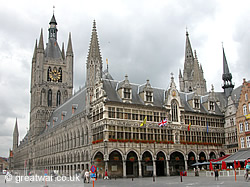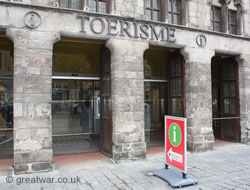Ieper - Ypres, Belgium
When the First World War was declared in August 1914 the town was known by it's French name of Ypres. Now the town is formally known by the Flemish name of Ieper and Flemish is the local spoken language. Being close to the French border, nevertheless, like many places in this locality the town is known by both names and visitors will find it signposted in both Flemish and French.
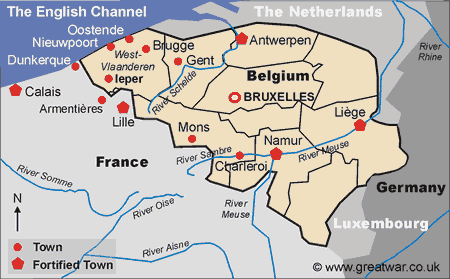
Ieper (Ypres) is an ancient city located in the Flemish province of West Flanders (West-Vlaanderen) in the Westhoek region of Belgium. The municipality of Ieper includes the city itself and a number of villages, namely Boezinge, Brielen, Dikkebus, Elverdinge, Hollebeke, Sint-Jan, Vlamertinge, Voormezele, Zillebeke and Zuidschote. Ieper and these villages count a population of around 35,000 inhabitants.
Ypres and WW1
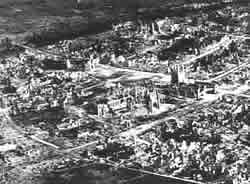
|
From October 1914, a few weeks after the outbreak of war in August 1914, the peaceful way of life in this part of Belgian Flanders was shattered by the arrival of massed military forces and their destructive weapons of war. On 7 October about 8,000 soldiers of the Imperial German Army arrived in Ypres. They ordered thousands of loaves of bread to be baked, raided the town's coffers and left the following day, having “passed through” Ypres.
“Wipers”
French and British soldiers arrived in the town a few days later, from 14 October, to put up a defence and to block the route for the German Army through Ypres to the ports on the French and Belgian coast. Soldiers in the British Army quickly turned the name of Ypres into a much easier word to pronounce. They called it “Wipers”. The Allies and the British Army remained in “Wipers” for four years from October 1914 to the end of the war in November 1918. Ypres never fell into German occupation during the war.
The defence of Ypres, or Wipers, was key to the British hold on this sector of the Western Front. The town was an important strategic landmark blocking the route for the Imperial German Army through to the Belgian and French coastal ports. Many thousands of Allied troops died to maintain the Allies' possession of this place. They died in the rubble of its buildings and the shattered farmland around it, fighting in ferocious battles and living in inhuman conditions. On the German side of the wire, many thousands of German lives were also lost in the landscape around Ypres during the German Army's four years of offensive and defensive battles.
By the end of the war the entire town lay in ruins, with only a handful of buildings left standing. Visitors coming to Ypres for the first time are usually astonished to think that the busy, vibrant town with its medieval and renaissance buildings was completely flattened and that virtually the whole of the town was reconstructed from scratch, stone by stone, brick by brick during the 1920's and 1930's.
Sights to See in Ieper/Ypres
Despite the devastation of Ypres by the end of 1918 many of the famous historic buildings in the reconstructed town were built as a close likeness to their original architecture. There are sights to see of First World War interest in Ypres, some of which are buildings of special historical significance which were destroyed by the war and which were rebuilt as a result of it.
For a listing with locations of the main sights to see in Ieper go to our page:
History of Ieper/Ypres
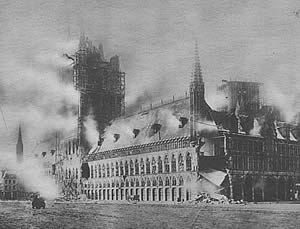
|
Find out more about the history of Ypres, from the origins of the town and its fortification to the part it played in the First World War:
Further Reading

Before Endeavours Fade
by Rose E B Coombs
The first modern guidebook to the Western Front battlefields, first published in 1976, by the late Rose E B Coombs. Regularly updated this is a highly recommended guidebook for the first time visitor. Using illustrated Michelin maps the guidebook takes the visitor on routes through the major battlefields from the Belgian coast to Verdun, passing all the important sites and including many of the not so well known landmarks and battle monuments.

Ypres in War and Peace
by Martin Marix Evans
Published by Pitkin Guides, English edition (June 1992); ISBN-10: 0853726108 & ISBN-13: 978-0853726104

Major and Mrs.Holt's Battlefield Guide to Ypres Salient (Major & Mrs Holt's Battlefield Guide) (Paperback)
by Tonie Holt and Valmai Holt
Published by Pen & Sword Books Ltd. Pap/Map edition (14 Feb 1997); 272 pages. ISBN-10: 0850525519 & ISBN-13: 978-0850525519

Walking the Salient: Ypres (Battleground Europe) (Paperback)
by Paul Reed
Published by Pen & Sword Books Ltd. (12 Jan 1998); 208 pages. ISBN-10: 0850526175 & ISBN-13: 978-0850526172

The Pathe Collection -The Battle of Ypres (DVD)
Format: PAL. Regions: All. (Release 8 November 2010); ASIN: B0045U3B0W
Related Topic
Visitor Centre for Ieper - Ypres
For information about the Visitor Centre for Ieper - Ypres & the Westhoek, it's location in the centre of Ypres and contact details see our page at:
Visitor Centre for Ypres & the Westhoek
Acknowledgements
(1) Photograph believed to be from a private collection.
(2) Photograph with grateful thanks to the Great War Primary Document Archive: Photos of the Great War:
Website: www.gwpda.org Photos

